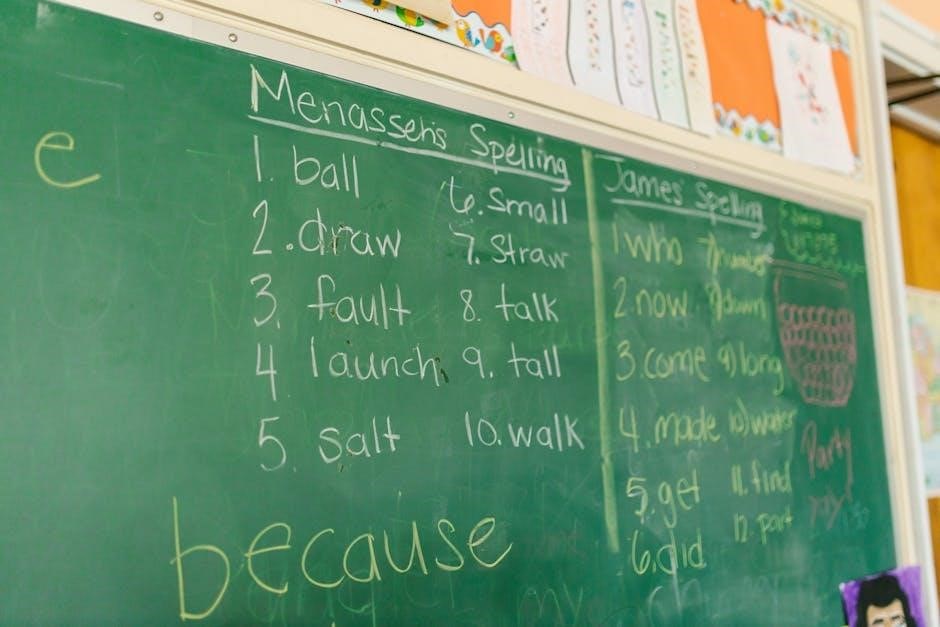Vocabulary Activities for Middle School: A Comprehensive Guide
Engage middle school students with dynamic vocabulary activities; Discover creative approaches and effective strategies to enhance word knowledge. Explore diverse games, worksheets, and collaborative stations. Equip students with essential vocabulary skills for academic success in any content area.
Effective Vocabulary Instruction in Middle School

Vocabulary instruction in middle school presents unique challenges, demanding engaging and effective strategies. As words become more complex, educators must ensure students not only understand but also retain essential concepts. Effective teaching involves integrating vocabulary into various content areas, making learning relevant and memorable.
Direct instruction of specific vocabulary words before reading can significantly improve comprehension. Activities should encourage students to use new words in novel contexts, promoting deeper understanding. Collaborative learning environments, such as vocabulary stations, provide opportunities for peer interaction and reinforcement.
Games and creative projects, like vocabulary quilts, can transform learning into an enjoyable experience. Utilizing resources such as word-definition lists and worksheets helps build a solid foundation. Incorporating academic vocabulary is crucial for success across subjects, enabling students to access complex information. By focusing on innovative and interactive methods, educators can cultivate a rich vocabulary that benefits students academically and beyond. These strategies foster excitement for vocabulary learning and create a vibrant classroom community.
Vocabulary Quilts: A Creative Approach

Vocabulary quilts offer a colorful and creative method to support vocabulary development in middle school. This project allows students to visually represent their understanding of new words through a patchwork of definitions, synonyms, antonyms, and related images. By middle school, students can create more detailed and thoughtful quilts, demonstrating a deeper engagement with the material.
Each quilt square focuses on a single vocabulary word, encouraging students to explore its various facets. This hands-on activity fosters critical thinking and reinforces retention as students synthesize information from multiple sources. The visual nature of the quilt aids in memory and provides a unique way to showcase learning.
Students can personalize their quilts with illustrations and creative designs, making the learning process more engaging. Completed quilts can be displayed in the classroom, serving as a constant reminder of the vocabulary learned. This interactive approach not only enhances vocabulary skills but also encourages artistic expression. The collaborative aspect of the project allows students to share ideas and learn from one another, creating a dynamic and supportive learning environment. Vocabulary quilts are an excellent way to transform vocabulary instruction into a memorable and enjoyable experience.
Word of the Week Activities
The “Word of the Week” activity is a straightforward yet effective method to consistently incorporate vocabulary instruction into your middle school classroom. Each week, introduce a new vocabulary word and engage students in a variety of activities centered around it. This approach helps build their vocabulary gradually and reinforces their understanding through repeated exposure.
Begin by presenting the word, its definition, and a clear example of its usage in a sentence. Encourage students to write their own sentences using the word, fostering active engagement and comprehension. Incorporate activities like synonym searches, antonym identification, and creating visual representations of the word’s meaning. You can also challenge students to find the word used in real-world contexts, such as in books, articles, or online content.
To make the activity more interactive, consider incorporating games or group discussions related to the weekly word. This could involve creating short skits, writing stories, or even designing a class poster that showcases the word and its various uses. The “Word of the Week” activity can be easily adapted to fit different subjects and learning styles, making it a versatile tool for enhancing vocabulary skills in middle school students. By maintaining consistency and creativity, you can transform this simple activity into a powerful means of vocabulary enrichment.
Vocabulary Luau: An Engaging Pre-Reading Activity
Transform your classroom into a tropical paradise with the “Vocabulary Luau,” a fun and engaging pre-reading activity designed to introduce key vocabulary terms before diving into a new text. This interactive exercise helps students connect with the material on a deeper level, making the reading experience more meaningful and memorable.
Begin by selecting a list of vocabulary words that are central to the upcoming reading. Create a festive atmosphere by decorating the classroom with Hawaiian-themed decorations, such as colorful leis, tiki torches (battery-operated), and tropical flowers. As students enter, greet them with a lei and explain the rules of the game. Present a series of scenarios or statements related to the vocabulary words. If a scenario applies to a particular word, students should say the word aloud; if it doesn’t, they remain silent.
For example, if the word is “radiant,” you might say, “Winning a million dollars,” “Earning a gold medal,” or “Having a picture you painted hung in the school.” This activity encourages active listening, critical thinking, and reinforces the meaning of each word in a memorable way. The “Vocabulary Luau” can be easily adapted to suit any subject or text, providing a dynamic and engaging way to prepare middle school students for reading.
Vocabulary Games for Secondary Students
Ignite a passion for words in secondary students through engaging vocabulary games! Transform mundane memorization into exciting challenges with interactive activities that reinforce word meanings and usage. Try “Vocabulary Pictionary,” where students illustrate terms for their peers to guess, fostering visual connections and collaborative learning. “Vocabulary Charades” brings words to life through dramatic interpretation, encouraging kinesthetic learners to actively participate.
Elevate the competition with “Vocabulary Jeopardy,” creating categories based on definitions, synonyms, and antonyms to test students’ comprehension. “Vocabulary Bingo” provides a familiar format with a twist, using word definitions as clues. Foster critical thinking with “Context Clues Challenge,” where students decipher word meanings from sentences. “Root Word Relay” builds understanding of word origins, enhancing vocabulary acquisition.
These games cater to diverse learning styles, making vocabulary acquisition fun and effective. Encourage teamwork, communication, and critical thinking while reinforcing essential vocabulary skills. Transform your classroom into a dynamic learning environment where students eagerly expand their word power through captivating games.
Vocabulary Truth or Dare and Choice Board Activity
Infuse excitement into vocabulary practice with “Truth or Dare”! Students choose between answering a vocabulary-related question truthfully or completing a daring challenge involving the word. This interactive game encourages active recall and creative application. For example, a “truth” question might ask for a sentence using the word “ubiquitous,” while a “dare” could involve acting out the definition of “benevolent.”
Complement this with a vocabulary choice board, offering students options to demonstrate their understanding. Options could include writing a short story using target words, creating a visual representation of the words’ meanings, or teaching the words to a classmate. The choice board promotes differentiated learning, allowing students to select activities that align with their strengths and interests.
By combining “Truth or Dare” with a choice board, you create a dynamic learning environment. Students are motivated to actively engage with vocabulary, reinforcing their understanding through diverse methods. This approach caters to various learning styles, ensuring all students can effectively expand their vocabulary while having fun.
Vocabulary Word-Definition Lists and Worksheets

Provide students with structured support through vocabulary word-definition lists. These lists serve as foundational resources, offering clear and concise definitions for target words. Supplement these lists with engaging worksheets designed to reinforce understanding. Worksheets can include matching exercises, fill-in-the-blanks, and sentence construction activities.
To maximize effectiveness, curate lists and worksheets tailored to specific texts or units of study. This contextualization ensures vocabulary acquisition is directly relevant to students’ learning experiences. Additionally, incorporate visual aids, such as images or diagrams, to enhance comprehension and memory retention.
Offer a variety of worksheet formats to cater to diverse learning styles. Some students may benefit from traditional exercises, while others may thrive with more creative tasks like creating their own crossword puzzles or writing short stories incorporating the target words. Regularly review the lists and worksheets to monitor student progress and address any areas of confusion. By combining structured lists with engaging worksheets, you provide a comprehensive approach to vocabulary development.
Strategies to Improve Middle School Vocabulary
Elevate middle school vocabulary skills with targeted strategies. Encourage students to actively read diverse texts to encounter new words in context. Promote consistent dictionary use to decipher unfamiliar terms. Teach root words, prefixes, and suffixes to unlock word meanings and boost comprehension. Implement spaced repetition to reinforce vocabulary retention over time.
Incorporate mnemonic devices to aid memory and recall. Foster a classroom environment that values word consciousness and curiosity. Encourage students to explore word origins and etymology.
Utilize technology to access online vocabulary resources and interactive games. Integrate collaborative activities like word sorts and semantic mapping to promote deeper understanding. Provide opportunities for students to use new words in writing and speaking assignments. Offer regular feedback to guide and motivate vocabulary development. By implementing these strategies, you empower middle schoolers to expand their lexicons effectively.
Academic Vocabulary for Middle School Students
Equip middle school students with essential academic vocabulary. Focus on terms frequently encountered across various subjects. Utilize research-based lists to identify key words in content areas. Implement strategies to help students develop in-depth knowledge of these terms. Encourage students to write definitions in their own words to enhance understanding. Employ graphic organizers to visually represent word relationships and connections.
Engage students in activities that require them to use academic vocabulary in context. Facilitate discussions where students can explain and debate word meanings. Incorporate games and interactive exercises to make learning fun and engaging. Provide opportunities for students to apply academic vocabulary in writing assignments.
Assess students understanding through quizzes and projects. Offer targeted support to students who struggle with specific terms. Promote a culture of vocabulary consciousness in the classroom. By mastering academic vocabulary, middle school students will be better equipped to access information and succeed academically.
Vocabulary Stations: Collaborative Learning
Transform vocabulary practice into a collaborative experience with vocabulary stations. Set up multiple stations, each focusing on a different aspect of vocabulary learning. Divide students into small groups and have them rotate through the stations. At each station, students work together to complete a specific task related to the target vocabulary words.
One station could involve creating sentences using the words, while another focuses on drawing images to represent their meanings. A third station could challenge students to find synonyms and antonyms. Another station could involve students to create original stories using the vocabulary words.
Encourage discussion and peer teaching at each station. Provide clear instructions and necessary materials for each activity. Monitor student progress and provide feedback as needed. Vocabulary stations promote active learning, teamwork, and deeper understanding of vocabulary words. By working together, students reinforce their learning and develop valuable collaboration skills. This helps them build a successful classroom.

